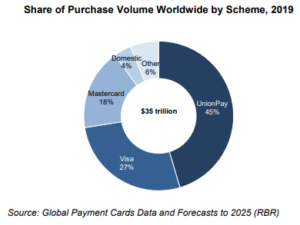Global payment card expenditure grew 13% last year, to reach $35 trillion, according to the latest industry research. Despite a frequent US and western-biased view that Visa and MasterCard hold the dominant global market share for payment cards, that’s not the case.

While the two US networks are strongly second and third largest in global payment card market share, China’s UnionPay holds 45.1% of the global market thanks to its dominant position in its home market.
Outside of China, however, UnionPay’s market share shrinks to just 1% according to new research from strategic research and consulting firm RBR’s new study – Global Payment Cards Data and Forecasts to 2025.
Changing consumer habits and COVID-19 boost card spending
The new report from RBR shows spending on payment cards continues to grow strongly. According to Global Payment Cards Data and Forecasts to 2020, expenditure rose by 13% to reach $35 trillion in 2019.
Among the factors driving this impressive growth in developing countries were government financial inclusion efforts to encourage people to open bank accounts for the first time. In more mature markets, contactless is accelerating as consumers move away from the use of cash, thanks to the COVID-19 crisis and health and hygiene concerns.
Who are the biggest global payment providers?

At 45%, UnionPay has the largest share of global card expenditure driven by spending in China, where UnionPay accounts for 93% of the total. It does work in partnership with more than 2,300 institutions worldwide with card acceptance in 179 countries and is issued in 61 nations.
RBR’s report shows that spending on Chinese cards has continued to rise. Debit cards, which have historically been used primarily for cash withdrawals, are increasingly being used for everyday payments by Chinese consumers.
Visa (including its sub-brands Visa Electron, V PAY and Interlink) and Mastercard (including Maestro and Mastercard Electronic) are the second and third largest schemes worldwide with 27% and 18% respectively.
However, RBR’s analysis shows that if China is excluded, the picture is significantly different – Visa is then the largest scheme with 39%, followed by Mastercard with 32%. UnionPay only has 1% of non-Chinese expenditure, highlighting the massive influence China has on global market shares.
While small, domestic payment networks’ market share rose slightly to 4% but are growing quickly, particularly in markets where new domestic schemes have launched with backing from governments, such as Russia and India. Iran also operates a large domestic-only system, as international sanctions prohibit the use of international cards.
E-commerce provides growth potential
As e-commerce continues to grow partly in response to the coronavirus pandemic, there is growth ahead for global payments networks.
RBR’s Daniel Dawson who led the research said, “There is still potential for growth in China, and therefore for UnionPay, as more consumers from rural areas enter the banking system. Meanwhile, the rise of e-commerce will provide more opportunities for international schemes more generally.”
You can read RBR’s research highlights here.








LET’S CONNECT